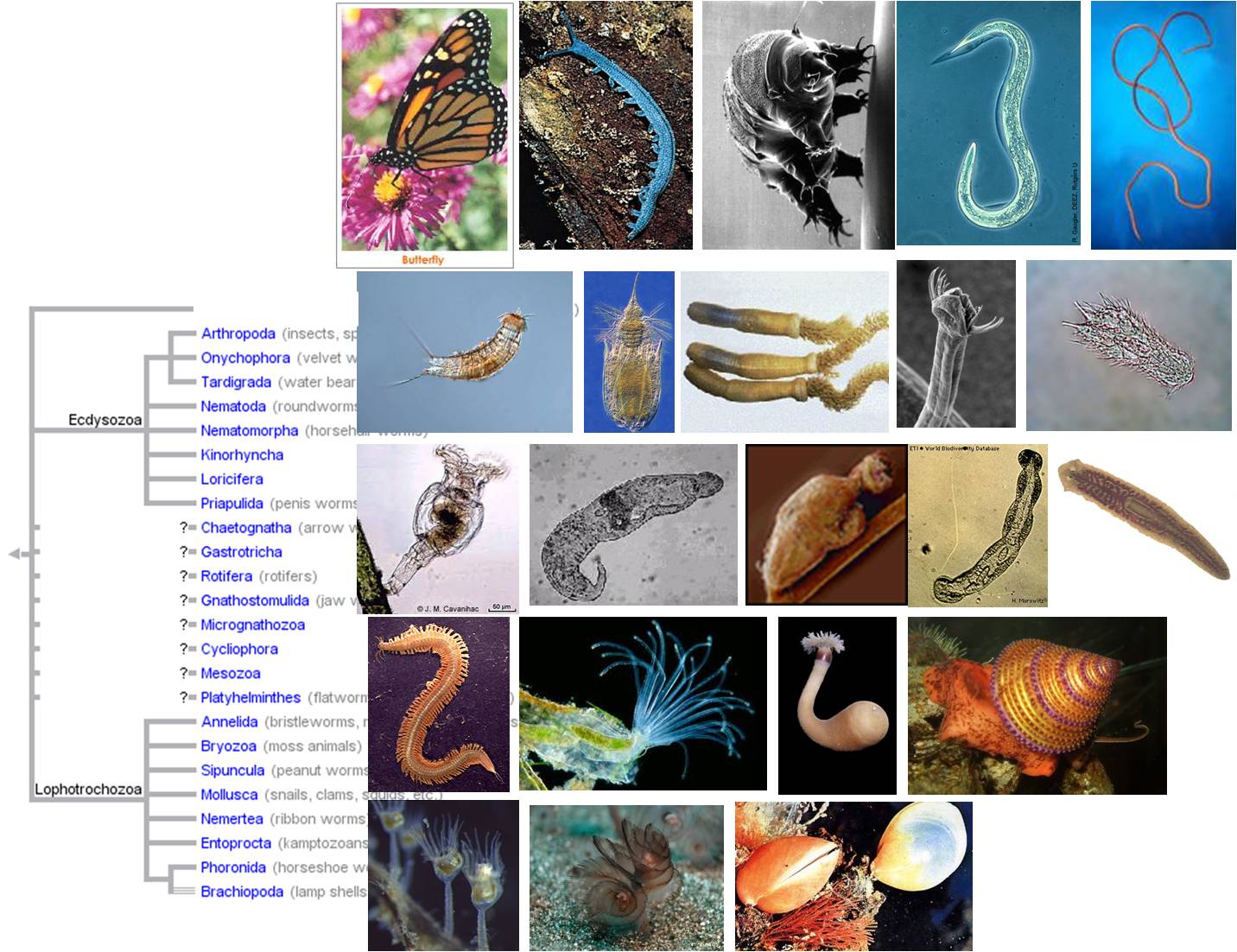 The
Diversity of Life
The
Diversity of Life  The
Diversity of Life
The
Diversity of Life 5. Major Phyla
a. Phylum Porifera: Sponges
b. Phylum Cnidaria: Hydra, anemones, corals, jellyfish
The "Bilateria"
Protostomes: Lophotrochozoans
Protostomes: Ecdysozoans
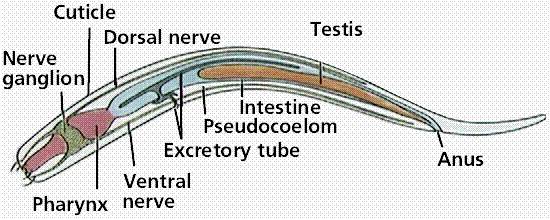 f.
Phylum Nematoda: Roundworms
f.
Phylum Nematoda: Roundworms
Like all Ecdysozoans, nematodes have a cuticle that must be shed in order for the animal to grow. In most nematodes, the cuticle is shed four times during the growth phase of the organism. Nematodes have a complete digestive tract and some cephalization, but they generally have a somewhat simplied and reduced body plan. Many are free-living in soil and aquatic environments, but many are parasitic, infecting all other forms of multicellular life. Nematode infections in humans cause trichinosis, filariasis, elephantiasis, and ascariasis.
g. Phylum Tardigrada: Waterbears
This is a curious phylum of the toughest animals on earth. They can tolerate temperatures above 150 C for short periods, and can be dehydrated to 1% of their normal water content for 10 years and be rehydrated. They can also tolerate the vaccuum of space and 6000 atmospheres of pressure! They are found in terrestrial, marine, and aquatic habitats from the poles to the tropics. Most eat plants, algae, or bacteria. With the onychophorans, they are the sister group to the arthropods.
h. Phylum Onychophora: Velvetworms
These animals have segmented bodies but lobe-like legs. They are thought to be a sister group to the arthropods, perhaps representing the living discendants of the link between the annelids and arthropods. They are tropical, and they capture prey by squirting them with a glue to subdue them.
i. Phylum Arthropoda
 The
arthropods are the most diverse animal group on earth, accounting for 85% of
all animal species. The are an ancient group that came to dominate during the
Cambrian period. The earliest groups were the Chelicerates and Trilobites. The
chelicerates are identified by having only two appendages forward of the mouth
- these are the small, typically pincer-like chelicerae. In spiders, the chelicerae
have evolved into fangs that deliver poison to subdue prey. The other group
of chelicerates are the Horseshoe crabs - an ancient relictual taxon. The other
major clade of arthropods are the mandibulata, which divide into the myriapods
(millipedes and centipedes) and the crustacea. Myriapods are segmented, without
much specialization; each body segment has similar paired appendages used for
walking Centipedes have one pair of legs per segment, and they are predatory;
they have poison glands like spiders and inject their prey to immobilize them.
Millipedes have two apirs of legs per segment. they are slower than centipedes,
and they feed on detritus. In the Eucrustacea, the segments have paired appendages
but they differ in length and function. In addition, they are biramous - having
two roots. One root is a leg, and the other is a gill. Curiously, the insects
are a group derived from aquatic crustaceans. They have flourished and radiated
in terrestrial environments like no other group in the history of our planet.
They have reduced, fused body parts, with appendages limited to head and thoracic
segments. Insect diversity is staggering, and this diversity has interested
ecologist for along time. Why are there so many species of insects? Well, their
diversity is testimony to their adaptability - their exoskeleton means that
they can tolerate dessication. Their small size means that they don't need many
resources to survive. Their power of flight means that they can disperse easily.
This means that they can find resources, but it also means that they are prone
to geographic isolation (and speciation). Finally, they are fecund - most insects
can lay many eggs and thus establish large populations quickly. For all these
reasons and many more, insects are prone to succeed and speciate.
The
arthropods are the most diverse animal group on earth, accounting for 85% of
all animal species. The are an ancient group that came to dominate during the
Cambrian period. The earliest groups were the Chelicerates and Trilobites. The
chelicerates are identified by having only two appendages forward of the mouth
- these are the small, typically pincer-like chelicerae. In spiders, the chelicerae
have evolved into fangs that deliver poison to subdue prey. The other group
of chelicerates are the Horseshoe crabs - an ancient relictual taxon. The other
major clade of arthropods are the mandibulata, which divide into the myriapods
(millipedes and centipedes) and the crustacea. Myriapods are segmented, without
much specialization; each body segment has similar paired appendages used for
walking Centipedes have one pair of legs per segment, and they are predatory;
they have poison glands like spiders and inject their prey to immobilize them.
Millipedes have two apirs of legs per segment. they are slower than centipedes,
and they feed on detritus. In the Eucrustacea, the segments have paired appendages
but they differ in length and function. In addition, they are biramous - having
two roots. One root is a leg, and the other is a gill. Curiously, the insects
are a group derived from aquatic crustaceans. They have flourished and radiated
in terrestrial environments like no other group in the history of our planet.
They have reduced, fused body parts, with appendages limited to head and thoracic
segments. Insect diversity is staggering, and this diversity has interested
ecologist for along time. Why are there so many species of insects? Well, their
diversity is testimony to their adaptability - their exoskeleton means that
they can tolerate dessication. Their small size means that they don't need many
resources to survive. Their power of flight means that they can disperse easily.
This means that they can find resources, but it also means that they are prone
to geographic isolation (and speciation). Finally, they are fecund - most insects
can lay many eggs and thus establish large populations quickly. For all these
reasons and many more, insects are prone to succeed and speciate.
In looking at the mandibulate groups, we see a nice example of an important evolutionary pattern: replication, specialization, and reduction. The myriapods have probably preserved the ancestral body plan within the Arthropoda. Like their probable annelid ancestors, the myriapods are composed of many similar segments. The Eucrustacea represent the next step in the evolution of many body plans - specialization of different body segments for particular functions. So, although every segment of the body of a eucrustacean has paired appendages (like myriapods), those appendages are different lengths and sizes and perform different functions. Appendages in the head are antennae and tiny feeding pincers. Appendages in the thorax are legs and claws (like in lobsters and crabs). Appendages in the abdomen are involved in reproduction (holding eggs, for instance). Next time you have lobster, crab, or shrimp, take a closer look at your meal and notice the paired appendages on each body sement that have become specialized for different functions. In the most derived group of crustaceans - the insects - there is fusion of segments in a given body region and the elimination of redundancy. The abdominal segments have fused into one body region, and the appendages have been lost. The thoracic segments have fused into one body region, and most segments have lost their legs - reducing the redundancy and getting by with 6. Likewise, head segments have fused, and insects have only one pair of antennae (unlike the 2 pairs of eucrustaceans). So, in this one clade, we see the important pattern of segmentation, specialization, and fusion / reduction as a mechanism to produce evolutionary novelty.
Deuterostomes:
j. Phylum Echinodermata: Sea stars, sea urchins, sea cucumbers, sand dollars
 Like
all deuterstomes, the blastopore forms the anus in this phylum. The echinoderms
have an internal skeleton consisting of separate plates that interlock. This
allows them flexibility, but also remarkable rigidity. The body axis of a starfish
is from the bottom, called the oral surface, to the top, called the aboral surface.
So, the legs radiate from the 'waist' of the animal. This symmetry is called
'pentaramous' symmetry. The other interesting adaptiation of echinoderms are
the internal canal system. They have tubes that fill tube feet, causing them
to extend and retract as they fill and deflate. This internal system of canals
is continuous with the environment, with a valve called the madreporite that
regulates water flow from the environment to the canals. The digestive tract
of a starfish is short, from the oral to aboral surface. But the efficiency
is increased by having digestive glands radiate out into the arms or the starfish.
Gonads are also in the limbs.
Like
all deuterstomes, the blastopore forms the anus in this phylum. The echinoderms
have an internal skeleton consisting of separate plates that interlock. This
allows them flexibility, but also remarkable rigidity. The body axis of a starfish
is from the bottom, called the oral surface, to the top, called the aboral surface.
So, the legs radiate from the 'waist' of the animal. This symmetry is called
'pentaramous' symmetry. The other interesting adaptiation of echinoderms are
the internal canal system. They have tubes that fill tube feet, causing them
to extend and retract as they fill and deflate. This internal system of canals
is continuous with the environment, with a valve called the madreporite that
regulates water flow from the environment to the canals. The digestive tract
of a starfish is short, from the oral to aboral surface. But the efficiency
is increased by having digestive glands radiate out into the arms or the starfish.
Gonads are also in the limbs.
k. Phylum Hemichordata: Acorn Worms
The hemichordates are an exclusively marine group. There are interesting because they have two of the four characteristics seen in the chordate: they have pharygeal gills slits and they have a hollow dorsal nerve chord. If you remember from the earthworm dissection, other phyla have ventral nerve chords.There are two major groups of hemichordates, and one group forms protective tubes out of collagen they secrete, and they filter feed with echinoderm-like arms.
l. Phylum Chordata: Tunicates, Cephalochordates, and Vertebrates
All chordates have four characteristics at some point in their development: 1) pharyngeal folds (or gill slits), 2) hollow dorsal nerve tube, 3) notochord, and 4) a post-anal tail. As you might suspect, the similarities among organisms in this phylum are most evident in the larval stages. Cephalochordates like Amphioxus probably maintain the ancestral condition within the phylum. They have swimming larvae, but adults burrow and either feed on detritus or filter feed using their gills as a sieve. The oldest chordate fossils - Pikaia from the Cambrian Period -have a morphology very similar to modern cephalochordates. The Urochordata - the tunicates - have adapted to a more specialized filter-feeding lifestyle. Although their larvae are mobile and similar to Amphioxus, they settle out on a substrate, on their backs, and fold head-to-tail. The pharynx becomes a filtering 'basket'.
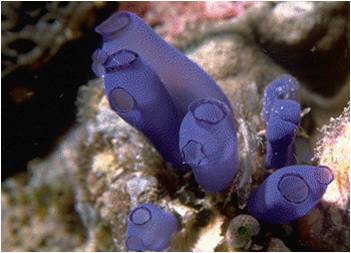 |
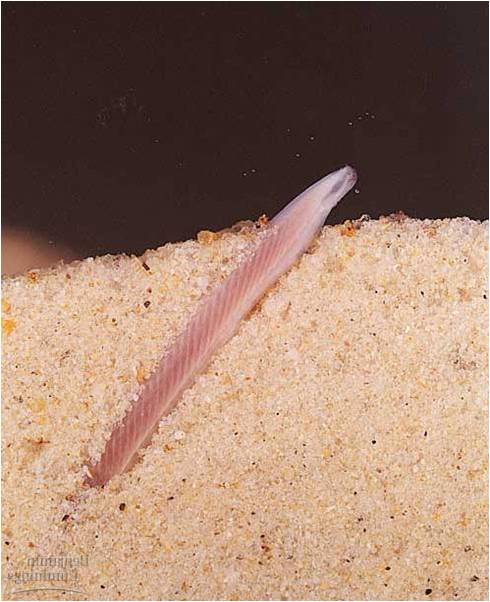 |
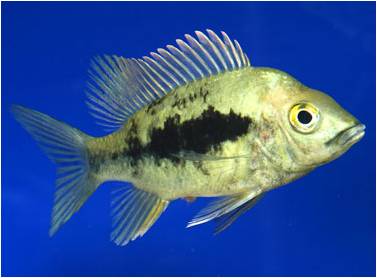 |
Urochordata: Tunicates |
Cephalochordata: Amphioxus |
Vertebrata |
Vertebrates represent the evolutionary lineage that went in the other direction: not towards a sedentary lifestyle but towards an active lifestyle. For the remainder of this unit, we will look at the evolutionary radiations within the vertebrates. We will see a typical pattern throughout this unit. A new group will evolve a novel trait or way of life. This will allow it to use a new environment, or use the environment in a new way. These lifestyles are called "adaptive zones", and they relate to ecological niches. Creation or entry into a new niche or zone means that there is no competition for resources. Under these conditions, almost any strategy using this new novel innovation will work - typically we see a radiation of new species exploiting this new way of life. As this adaptive zone or niche fills with species, they begin to compete. This leads to 'competitive contraction' of diversity, with only a few winners. The same thing happens in any situation where there are potentially limted resources. A new innovation, like the internet, provides opportunities to new businesses. Many flourish initially - like the many browser providers that were present in the '90's. Anyone remember when Netscape was the primary internet provider? Economists call that period the "dot-com boom", when internet companies could get a start just by colonizing this new open marketplace. As companies grew, they began to compete; and there were winners that maintained their position in the niche, and losers that went extinct. The same thing can happen in ecological systems. Competitive contraction can occur within a clade, or as a consequence of a more efficient, new evolutionary novelty arising. Henry Ford's Model T not only put many other car makers out of business, it also puts LOTS of horse-driven carriage companies out of business! So, as a more advanced, efficient group evolves, we sometimes see contraction in the abundance of ancestral forms... just as Darwin predicted.
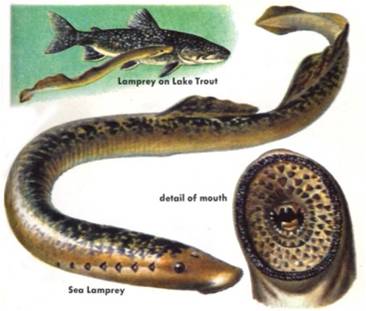 The
jawless fishes:
The vertebrates are distinguished by having an internal supportive spine that
is subdivided into units called vertebrae. This segmentation of the vertebral
column allows the animal to bend and move with more precision; with some parts
of the body moving while other parts remain stationary. The most primitive members
of this clade are the jawless fishes. The modern representatives are the hagfish
and the lampreys. The hagfish actually lack a subdivided vertebral column, but
they do have a skull surrounding their brain. As such, sometimes the "vertebrata"
are more specifically described as having a skull (to include the hagfish).
Both hagfish and lampreys have immature stages that look almost identical to
cephalochordates, also suggesting their primitive position within this clade.
So, the jawless fish evolve in the Cambrian and radiate in the Ordovician and
Silurian Periods, with many large, detritivorous and filter feeding species
scouring the benthos for food. In more advanced forms, the mouth cavity and
pharynx evolved for feeding, relieving the gills of this filtering function.
These jawless fish probably sucked in small invertebrates by rapidly opening
their mouth.
The
jawless fishes:
The vertebrates are distinguished by having an internal supportive spine that
is subdivided into units called vertebrae. This segmentation of the vertebral
column allows the animal to bend and move with more precision; with some parts
of the body moving while other parts remain stationary. The most primitive members
of this clade are the jawless fishes. The modern representatives are the hagfish
and the lampreys. The hagfish actually lack a subdivided vertebral column, but
they do have a skull surrounding their brain. As such, sometimes the "vertebrata"
are more specifically described as having a skull (to include the hagfish).
Both hagfish and lampreys have immature stages that look almost identical to
cephalochordates, also suggesting their primitive position within this clade.
So, the jawless fish evolve in the Cambrian and radiate in the Ordovician and
Silurian Periods, with many large, detritivorous and filter feeding species
scouring the benthos for food. In more advanced forms, the mouth cavity and
pharynx evolved for feeding, relieving the gills of this filtering function.
These jawless fish probably sucked in small invertebrates by rapidly opening
their mouth.
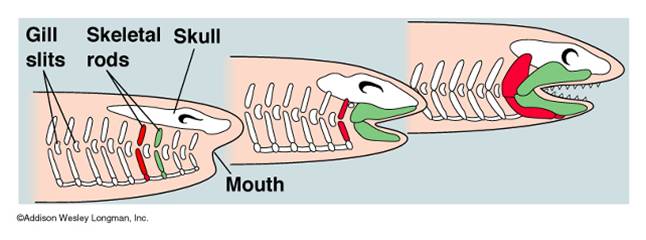 The
Gnathostomes: The Jawed Vertebrates: Jawed fishes evolved
in the Silurian and came to dominate and radiate in the Devonian - the "Age
of Fishes". Jaws evolved from the anterior gill arches, which flex and
became associated withe the mouth. Jaws allowed fish to become more efficient
predators, killing things bigger than could fit in their mouth through suction,
or strong enough to escape the suctioning force. In short, jaws were adaptive
because fish now became mobile, active predators - entering a niche previously
only occupied by large invertebrate predators. The first jawed fish radiation
were the placoderms, symbolized by the frightening Arthrodire predators like
Dunkleosteus, with its huge slicing jaw plates. The placoderms were
very heavy, however, and were displaced by more efficient swimmers - the cartilaginous
jawed fishes (Class Chondrichthyes). Modern representatives of this group are
sharks and rays.
The
Gnathostomes: The Jawed Vertebrates: Jawed fishes evolved
in the Silurian and came to dominate and radiate in the Devonian - the "Age
of Fishes". Jaws evolved from the anterior gill arches, which flex and
became associated withe the mouth. Jaws allowed fish to become more efficient
predators, killing things bigger than could fit in their mouth through suction,
or strong enough to escape the suctioning force. In short, jaws were adaptive
because fish now became mobile, active predators - entering a niche previously
only occupied by large invertebrate predators. The first jawed fish radiation
were the placoderms, symbolized by the frightening Arthrodire predators like
Dunkleosteus, with its huge slicing jaw plates. The placoderms were
very heavy, however, and were displaced by more efficient swimmers - the cartilaginous
jawed fishes (Class Chondrichthyes). Modern representatives of this group are
sharks and rays.
 The
Devonian also saw the radiation of the most successful group of fish on earth,
the bony fish (Class Osteichthyes). Unlike cartilage, bone is hollow and light;
it is also more rigid than cartilage, providing more resistance and efficiency
to muscles. The bony fish also had a swim bladder, whcih they used to maintain
neutral bouyancy in the water column. This means that they can maintain position
without swimming; Condrichthyes must swim to maintain vertical position in the
water column - otherwise they sink. These two adaptations of the bony fishes
made them more energetically efficient and faster than the cartilaginous fish,
and the bony fishes have radiated to the point where they represent 40% of all
vertebrate species today (not just fish - vertebrates..!!). Two important clades
evolved within the bony fishes: 1) the ray-finned fishes that came to dominate
the aquatic environments of the planet; and 2) the lob-finned fishes that radiated
into shallow-water environments. The lobe-finned fishes, swimming in shallow,
oxygen-poor waters of the Devonian, gulping air at the surface and pulling themselves
along on their forefins, evolved into the terrestrial tetrapods. Arthropods
had already colonized land, so there was ample food and oxygen for a large terrestrial
predator. As you have seen, the fossil record nicely documents the transition
from fish to these primitive amphibians.
The
Devonian also saw the radiation of the most successful group of fish on earth,
the bony fish (Class Osteichthyes). Unlike cartilage, bone is hollow and light;
it is also more rigid than cartilage, providing more resistance and efficiency
to muscles. The bony fish also had a swim bladder, whcih they used to maintain
neutral bouyancy in the water column. This means that they can maintain position
without swimming; Condrichthyes must swim to maintain vertical position in the
water column - otherwise they sink. These two adaptations of the bony fishes
made them more energetically efficient and faster than the cartilaginous fish,
and the bony fishes have radiated to the point where they represent 40% of all
vertebrate species today (not just fish - vertebrates..!!). Two important clades
evolved within the bony fishes: 1) the ray-finned fishes that came to dominate
the aquatic environments of the planet; and 2) the lob-finned fishes that radiated
into shallow-water environments. The lobe-finned fishes, swimming in shallow,
oxygen-poor waters of the Devonian, gulping air at the surface and pulling themselves
along on their forefins, evolved into the terrestrial tetrapods. Arthropods
had already colonized land, so there was ample food and oxygen for a large terrestrial
predator. As you have seen, the fossil record nicely documents the transition
from fish to these primitive amphibians.
Study Questions:
1. What distinguishes the ecdysozoans from the lophotrochozoans?
2. Name two diseases that nematodes cause.
3. Be able to identify pictures of Tardigrades, onychophorans, and the other phyla listed here.
4. What distinguishes the myriapods from the chelicerates?
5. What important evolutionary pattern do we see in the mandibulate groups - going from myriapods to eucrustaceans to insects?
6. List the characteristics of the Hemichordates and Chordates
7. Describe the body plan of a starfish.
8. How do tunicates, cephalochardates, and vertebrates differ?
9. How did ancestral jawless fishes feed? How do hagfish and lamprey feed today (check the book or do a search)?
10. How did the jaw evolve and what benefit did it provide?
11. Distinguish between the cartilaginous fish, the bony fish, the ray-finned fish, and the lobe-finned fish.